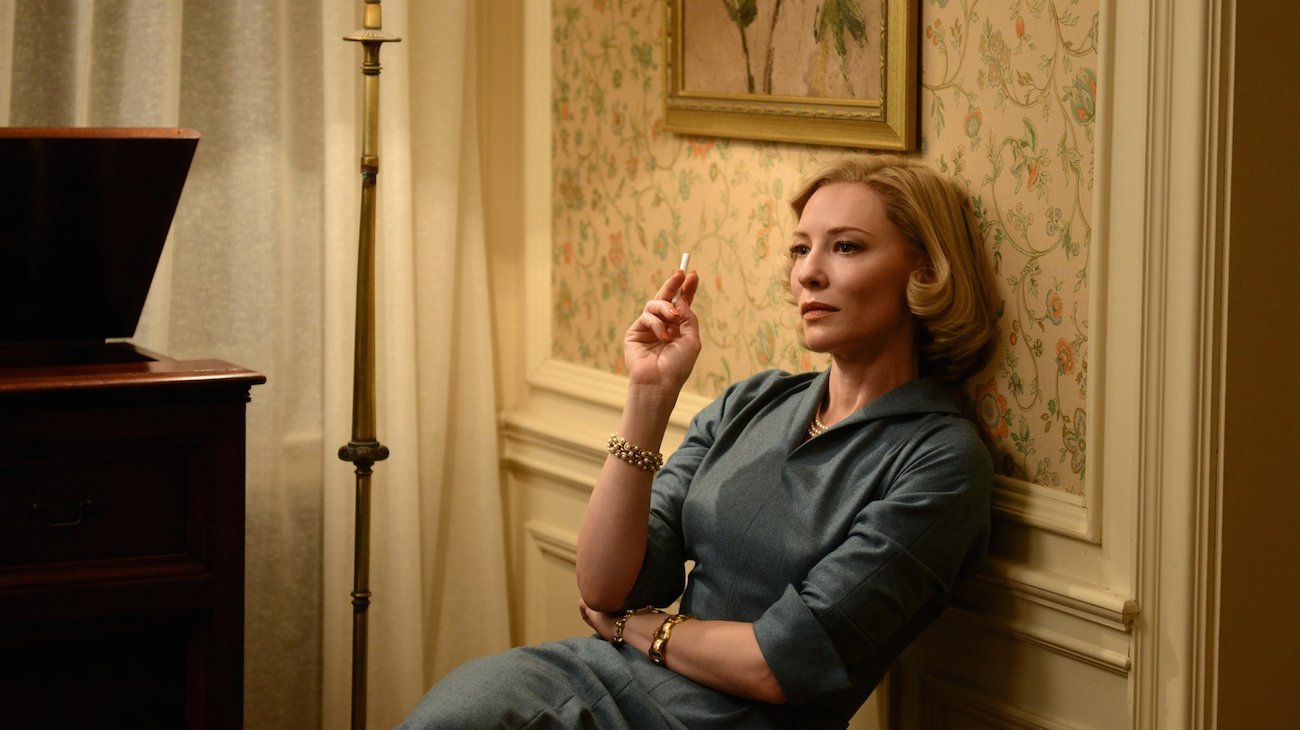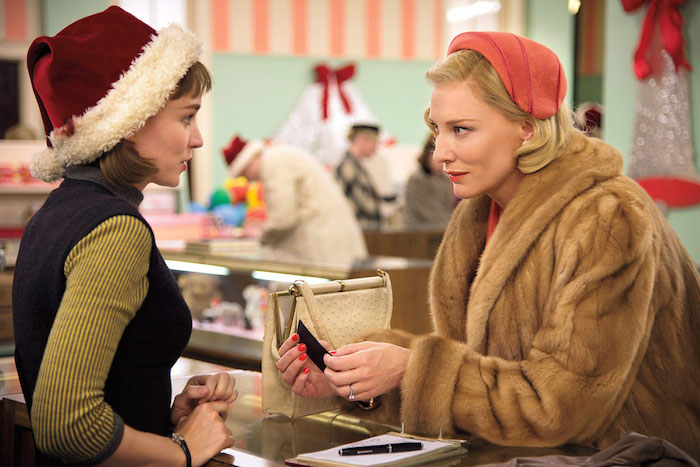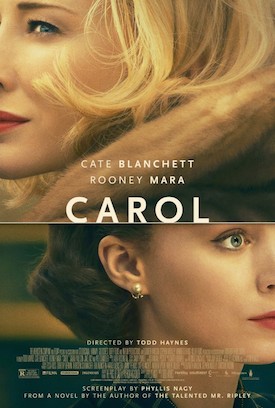 Todd Haynes’ latest film, Carol, an adaptation of Patricia Highsmith’s seminal novel The Price of Salt, follows two women from very different backgrounds who find themselves in an unexpected love affair in 1950s New York. A young woman in her 20s, Therese Belivet (Rooney Mara), is a clerk working in a Manhattan department store and dreaming of a more fulfilling life when she meets Carol (Cate Blanchett), an alluring woman trapped in a loveless, convenient marriage. Their immediate connection eventually turns into a much deeper connection, but the conventions of the time creates serious problems for the women. With a screenplay by Phyllis Nagy, Carol also stars Kyle Chandler, Sarah Paulson, and Jake Lacy. Three-time Oscar winner Sandy Powell (Shakespeare in Love, The Aviator, Young Victoria) played a huge role in helping Haynes perfectly recreate the bygone era of Highsmith’s story. I talked to her about her role in this and the other amazing films she’s worked on.
Todd Haynes’ latest film, Carol, an adaptation of Patricia Highsmith’s seminal novel The Price of Salt, follows two women from very different backgrounds who find themselves in an unexpected love affair in 1950s New York. A young woman in her 20s, Therese Belivet (Rooney Mara), is a clerk working in a Manhattan department store and dreaming of a more fulfilling life when she meets Carol (Cate Blanchett), an alluring woman trapped in a loveless, convenient marriage. Their immediate connection eventually turns into a much deeper connection, but the conventions of the time creates serious problems for the women. With a screenplay by Phyllis Nagy, Carol also stars Kyle Chandler, Sarah Paulson, and Jake Lacy. Three-time Oscar winner Sandy Powell (Shakespeare in Love, The Aviator, Young Victoria) played a huge role in helping Haynes perfectly recreate the bygone era of Highsmith’s story. I talked to her about her role in this and the other amazing films she’s worked on.
Danny Miller: I hardly ever get to talk to costume designers so I feel especially lucky to talk to both you and Daniel Orlandi who did the costumes for Trumbo in the same week.
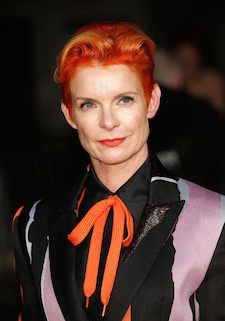 Sandy Powell: Oh, that would have been a great one to work on — Hollywood in the 50s which was quite different from the world of Carol. I did a bit of that in The Aviator which was a lot of fun.
Sandy Powell: Oh, that would have been a great one to work on — Hollywood in the 50s which was quite different from the world of Carol. I did a bit of that in The Aviator which was a lot of fun.
Yes, this is the third time you’ve worked with Cate Blanchett. I thought your Katharine Hepburn outfits for her in The Aviator were total perfection.
I loved doing those! I wish I could do more — how about a whole film about Katharine Hepburn? It would be fantastic to dress Spencer Tracy, too!
As a layperson, I have to assume that period films are more fun for costume designers to work on. Is that true?
Well, I definitely prefer them. It’s funny, though, people think contemporary films are “easy” to do but they’re actually quite difficult. One of the things that’s challenging about them is that everybody has an opinion, everything thinks they know all about contemporary clothes, whereas in a period film you’re left to your own devices a bit more.
I saw that amazing Hollywood Costume Exhibition at the Victoria & Albert Museum in London and then when it came here that included that wonderful chat between you and Martin Scorsese about doing the costumes for The Gangs of New York. You’ve worked with many directors who seem to be very involved with every detail of their films — is that the kind of collaboration that you prefer?
You know, they’re all different. I don’t think I’ve ever worked with a director who’s so specific they’re saying, “I want the character to be wearing this,” but I do think the directors I enjoy working with the most are the very visual ones. Todd, certainly, Marty, Derek Jarman who was the first director I ever worked with, and of course, Neil Jordan who I did a spate of films with.
Are there often specific things in the script that dictate the costume design?
There are but I usually take no notice of those! (Laughs.) I mean, sometimes the script will say, “She’s wearing a green dress,” but I don’t pay much attention to that unless there’s a very good reason for it in the story.
Like Bette Davis’s red dress in Jezebel.
Exactly! Or the red coat in Don’t Look Now — actual plot points. But otherwise I don’t take that much direction from the script. Especially since the characters tend to change a lot once you start working.
This film takes place in a very defined era but the two women are from extremely different walks of life. I love how that is shown so beautifully through their clothes.
It’s all about making them believable characters, that’s really the whole point of costume design. Therese’s clothes would definitely not be the current bang-up fashion. She had no money so what she wore was very practical and warm. Clothes were not her priority. Carol, on the other hand, has chosen everything she wears quite deliberately.
I assume you work very closely with the actors early on in the process?
Yes. We didn’t have that much prep time for this film but I always like to involve the actors in the discussions of what they’ll be wearing. A lot of the designing actually happens during the fittings. I’ll talk with the actor at length about their character and we’ll get a seed of an idea that I’ll develop. Of course some actors contribute more than others.
It must be thrilling to dress someone like Cate Blanchett. After seeing you transform her into Katharine Hepburn, I’m excited to hear that she’s doing that upcoming Lucy movie.
Oh my God, I would LOVE to do that! I can completely imagine Cate being Lucille Ball. You just know that she could do it, I can just imagine how she’d do the eyes.
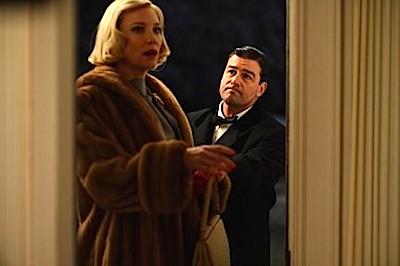 You have to work on that film! I also love the men’s clothes in this film. I’d kill to wear one of Kyle Chandler’s suits — all that beautiful flowing 50s fabric.
You have to work on that film! I also love the men’s clothes in this film. I’d kill to wear one of Kyle Chandler’s suits — all that beautiful flowing 50s fabric.
Actually, it’s not flowing at all, those suits were made of very rigid wool. 1950s wool was really quite heavy and thick, but it molded itself on the body beautifully, and Kyle Chandler is a good old-fashioned figure of a man — he was the perfect size for a man of the 1950s!
I assume you worked pretty closely with Judy Becker, the production designer, to make sure everything worked together?
Oh yes, as closely as we could even though it was a challenge logistically since I was prepping in New York and L.A., and she was mostly in Cincinnati where the film was shot. But I had a pretty good idea of the color palettes of all the interiors.
Do you have to make multiple copies of every outfit in case something happens to it?
I don’t think we had multiples of anything in Carol, it all depends on what happens to the characters in the scene. If somebody gets caught in a rainstorm, you have to have several versions of the costume because you know they’re going to shoot the rain scene first and then the dry scenes. Depending on the film, I’ve had to make as many as 20 copies of something.
What else do you have to worry about besides rain?
Well, for the film I’m doing at the moment, there’s a scene with a kid at a party and someone throws up on him. And, of course, the scene they’re shooting first is the scene of him walking home, having been vomited on! So you have to put the vomit on the clothes, not knowing what’s going to happen in the take. Or you have a scene where somebody has been shot and they have blood on them, but you don’t know exactly what’s going to happen in the take where they get shot so you have to guess and hope you put the blood in the right place.
Wow, I never thought that someone in your position would be focusing so much on vomit and blood!
Oh, you wouldn’t believe the huge discussions we have about vomit. What’s in the vomit? What did the character just eat? Is it going to be thick or runny? That kind of thing.
And I assume you pay a lot of attention to the undergarments characters wear, even if we’re not seeing them.
Yes, well, they have to be historically accurate for the women or you’ll never get the right silhouette, especially when the movie is set in the 1950s. If I had used modern bras in this film, the women would have looked completely different.
Were there certain costume designers you admired when you were growing up?
One of the first films that I remember noticing the costumes in was Visconti’s Death in Venice. Those were done by Piero Tosi who I’ve since met. He’s a very old man now but he teaches costume design and he actually teaches my work which I have to say is a huge honor.
Are there any eras that you’re dying to get your hands on, other than Cate Blanchett’s Lucy movie?
Yes, all the ones I haven’t done yet. I’ve actually never done a real 60s movie, I would so love to do that!

